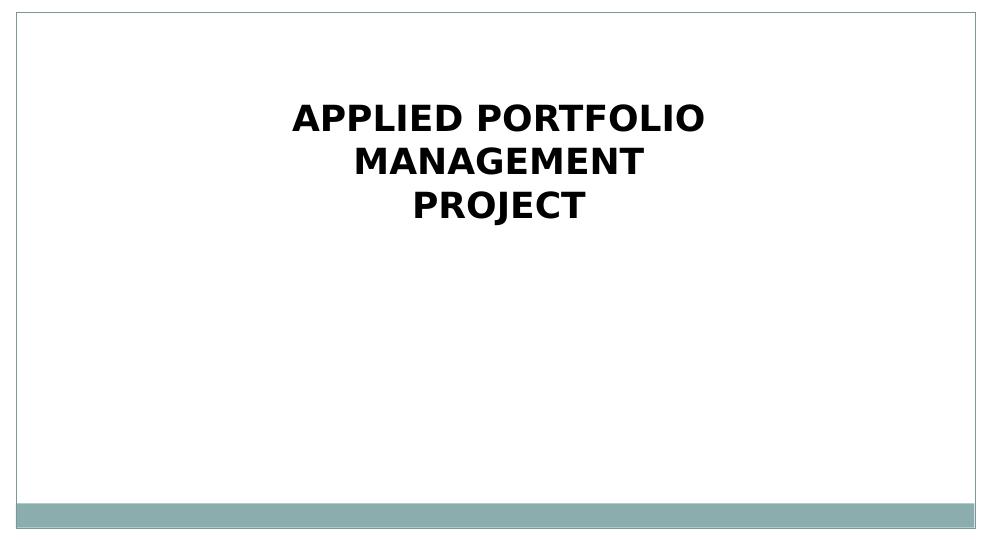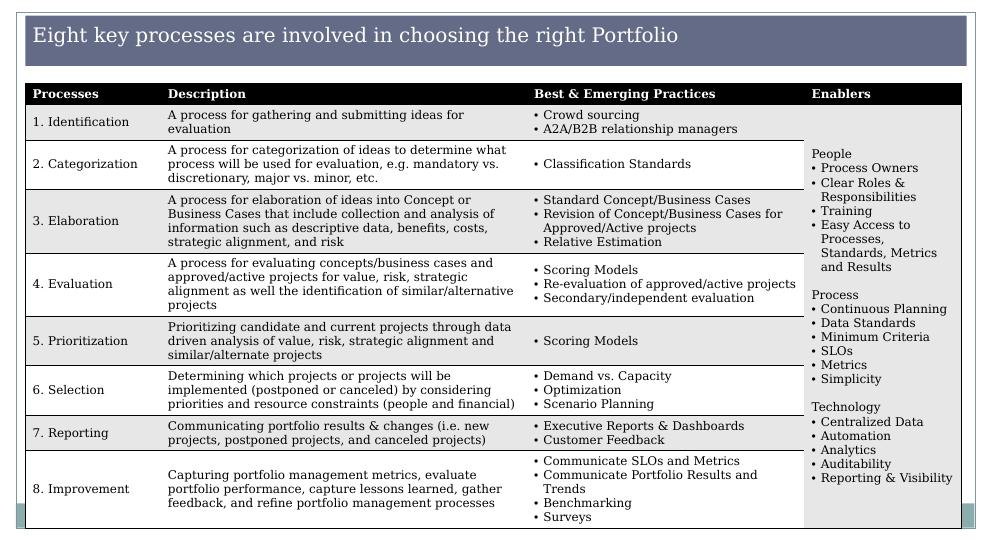Applied Portfolio Management Project: Essential Processes, Standards, and Performance Improvement
Added on 2023-06-11
11 Pages1167 Words54 Views
APPLIED PORTFOLIO
MANAGEMENT
PROJECT
MANAGEMENT
PROJECT

Introduction What are the essential processes in portfolio management? Why is it becoming more important today?
Establishing Portfolio
Standards
Allocation of time and budget.
Defining your
Strategic Portfolio
Determination of strategic goals based on the selected criteria
Evaluating Your
Portfolio
This is the step where one can perform critical what-if scenario planning that can empower your agency to
make smarter portfolio decisions about investment mix, project selection, timing, execution, sourcing,
performance and anticipated outcomes.
Improving Portfolio
Performance
Demand analysis based on budget allocation and time management.
Topics
Establishing Portfolio
Standards
Allocation of time and budget.
Defining your
Strategic Portfolio
Determination of strategic goals based on the selected criteria
Evaluating Your
Portfolio
This is the step where one can perform critical what-if scenario planning that can empower your agency to
make smarter portfolio decisions about investment mix, project selection, timing, execution, sourcing,
performance and anticipated outcomes.
Improving Portfolio
Performance
Demand analysis based on budget allocation and time management.
Topics

• Gathering candidate ideas for investment from various sources (internal and external)
• Considering candidate and approved projects based upon an analytic decision making framework
• Choosing highly ranked projects that together meet constraints for budget and resources.
• Reporting on changes, progress, and results in the portfolio
• Reconsidering the portfolio on an ongoing basis
• Practicing continuous improvement of Portfolio Management processes.
What is Portfolio Management?
• Considering candidate and approved projects based upon an analytic decision making framework
• Choosing highly ranked projects that together meet constraints for budget and resources.
• Reporting on changes, progress, and results in the portfolio
• Reconsidering the portfolio on an ongoing basis
• Practicing continuous improvement of Portfolio Management processes.
What is Portfolio Management?

Eight key processes are involved in choosing the right Portfolio
Processes Description Best & Emerging Practices Enablers
1. Identification A process for gathering and submitting ideas for
evaluation
• Crowd sourcing
• A2A/B2B relationship managers
People
• Process Owners
• Clear Roles &
Responsibilities
• Training
• Easy Access to
Processes,
Standards, Metrics
and Results
Process
• Continuous Planning
• Data Standards
• Minimum Criteria
• SLOs
• Metrics
• Simplicity
Technology
• Centralized Data
• Automation
• Analytics
• Auditability
• Reporting & Visibility
2. Categorization
A process for categorization of ideas to determine what
process will be used for evaluation, e.g. mandatory vs.
discretionary, major vs. minor, etc.
• Classification Standards
3. Elaboration
A process for elaboration of ideas into Concept or
Business Cases that include collection and analysis of
information such as descriptive data, benefits, costs,
strategic alignment, and risk
• Standard Concept/Business Cases
• Revision of Concept/Business Cases for
Approved/Active projects
• Relative Estimation
4. Evaluation
A process for evaluating concepts/business cases and
approved/active projects for value, risk, strategic
alignment as well the identification of similar/alternative
projects
• Scoring Models
• Re-evaluation of approved/active projects
• Secondary/independent evaluation
5. Prioritization
Prioritizing candidate and current projects through data
driven analysis of value, risk, strategic alignment and
similar/alternate projects
• Scoring Models
6. Selection
Determining which projects or projects will be
implemented (postponed or canceled) by considering
priorities and resource constraints (people and financial)
• Demand vs. Capacity
• Optimization
• Scenario Planning
7. Reporting Communicating portfolio results & changes (i.e. new
projects, postponed projects, and canceled projects)
• Executive Reports & Dashboards
• Customer Feedback
8. Improvement
Capturing portfolio management metrics, evaluate
portfolio performance, capture lessons learned, gather
feedback, and refine portfolio management processes
• Communicate SLOs and Metrics
• Communicate Portfolio Results and
Trends
• Benchmarking
• Surveys
Processes Description Best & Emerging Practices Enablers
1. Identification A process for gathering and submitting ideas for
evaluation
• Crowd sourcing
• A2A/B2B relationship managers
People
• Process Owners
• Clear Roles &
Responsibilities
• Training
• Easy Access to
Processes,
Standards, Metrics
and Results
Process
• Continuous Planning
• Data Standards
• Minimum Criteria
• SLOs
• Metrics
• Simplicity
Technology
• Centralized Data
• Automation
• Analytics
• Auditability
• Reporting & Visibility
2. Categorization
A process for categorization of ideas to determine what
process will be used for evaluation, e.g. mandatory vs.
discretionary, major vs. minor, etc.
• Classification Standards
3. Elaboration
A process for elaboration of ideas into Concept or
Business Cases that include collection and analysis of
information such as descriptive data, benefits, costs,
strategic alignment, and risk
• Standard Concept/Business Cases
• Revision of Concept/Business Cases for
Approved/Active projects
• Relative Estimation
4. Evaluation
A process for evaluating concepts/business cases and
approved/active projects for value, risk, strategic
alignment as well the identification of similar/alternative
projects
• Scoring Models
• Re-evaluation of approved/active projects
• Secondary/independent evaluation
5. Prioritization
Prioritizing candidate and current projects through data
driven analysis of value, risk, strategic alignment and
similar/alternate projects
• Scoring Models
6. Selection
Determining which projects or projects will be
implemented (postponed or canceled) by considering
priorities and resource constraints (people and financial)
• Demand vs. Capacity
• Optimization
• Scenario Planning
7. Reporting Communicating portfolio results & changes (i.e. new
projects, postponed projects, and canceled projects)
• Executive Reports & Dashboards
• Customer Feedback
8. Improvement
Capturing portfolio management metrics, evaluate
portfolio performance, capture lessons learned, gather
feedback, and refine portfolio management processes
• Communicate SLOs and Metrics
• Communicate Portfolio Results and
Trends
• Benchmarking
• Surveys

End of preview
Want to access all the pages? Upload your documents or become a member.
Related Documents
Project Portfolio Managementlg...
|17
|4489
|31
Project Management Assignment 2022lg...
|12
|2778
|22
